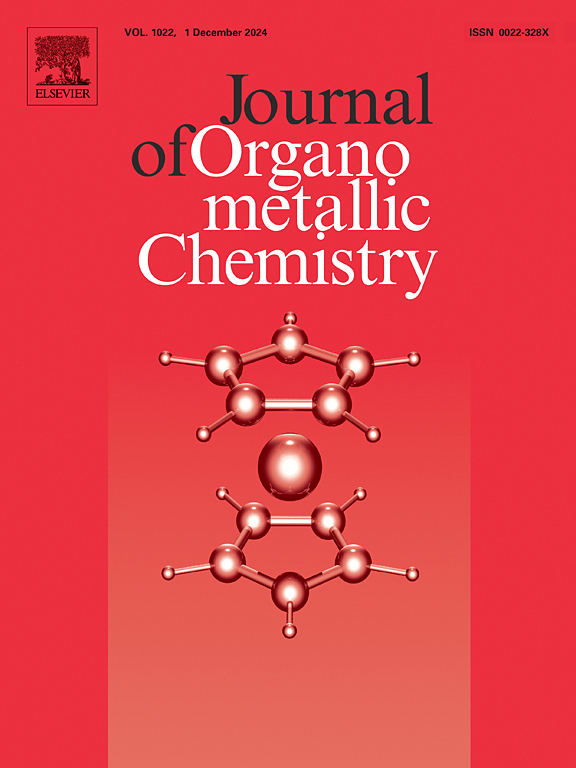Revisiting [Fe(bipy)2Et2]: electronic structure and new considerations on the thermal decomposition mechanism
IF 2.1
3区 化学
Q3 CHEMISTRY, INORGANIC & NUCLEAR
引用次数: 0
Abstract
The present computational investigation discredits a previously proposed mechanism for the thermal decomposition of the title compound in THF, according to which β-H elimination from one Et ligand would occur after an initial rearrangement of one bipy ligand from κ2 to κ1. It is alternatively proposed that the initial step is full replacement of one bipy ligand with one solvent molecule, to yield 5-coordinate [(bipy)(THF)FeEt2]. The title compound, the 5-coordinate [(κ2-bipy)(κ1-bipy)FeEt2], the 5-coordinate [(bipy)(THF)FeEt2] and the 6-coordinate [(bipy)(THF)2FeEt2] complexes have been analyzed in all possible spin states. While [(bipy)2FeEt2] is diamagnetic, but suggested by the calculation to rather adopt an open-shell (broken-symmetry) singlet with a low spin (S = ½) FeIII and non-innocent bipy ligands, [(bipy)2]•-, the other three systems have a broken-symmetry triplet ground state (S = 1 overall) with an intermediate spin (S = 3/2) FeIII. The low computed Gibbs energy cost for the bipy/THF substitution (5.6 kcal mol-1) makes [(bipy)(THF)FeEt2] a kinetically competent intermediate. Full bipy dissociation prior to the β-H elimination step is also consistent with the previously observed dependence of the decomposition rate on the solvent donor properties.

重述[Fe(bipy)2Et2]:电子结构及对热分解机理的新思考
目前的计算研究否定了先前提出的标题化合物在THF中热分解的机制,根据该机制,一个Et配体的β-H会在一个bipy配体从κ2重排到κ1后发生消除。也有人提出,初始步骤是用一个溶剂分子完全取代一个bipy配体,得到5-坐标[(bipy)(THF)FeEt2]。标题化合物,5-坐标[(κ2-bipy)(κ1-bipy)FeEt2], 5-坐标[(bipy)(THF)FeEt2]和6-坐标[(bipy)(THF)2FeEt2]配合物在所有可能的自旋态下进行了分析。虽然[(bipy)2FeEt2]是抗磁性的,但计算建议采用低自旋(S = 1 /2) FeIII的开壳(破对称)单重态和非对称的bipy配体,[(bipy)2]•-,其他三个体系具有具有中间自旋(S = 3/2) FeIII的破对称三重态基态(总体S = 1)。bipy/THF取代的低吉布斯能量成本(5.6 kcal mol-1)使[(bipy)(THF)FeEt2]成为一种具有动力学能力的中间体。在β-H消除步骤之前的完全bipy解离也与先前观察到的分解速率对溶剂供体性质的依赖一致。
本文章由计算机程序翻译,如有差异,请以英文原文为准。
求助全文
约1分钟内获得全文
求助全文
来源期刊

Journal of Organometallic Chemistry
化学-无机化学与核化学
CiteScore
4.40
自引率
8.70%
发文量
221
审稿时长
36 days
期刊介绍:
The Journal of Organometallic Chemistry targets original papers dealing with theoretical aspects, structural chemistry, synthesis, physical and chemical properties (including reaction mechanisms), and practical applications of organometallic compounds.
Organometallic compounds are defined as compounds that contain metal - carbon bonds. The term metal includes all alkali and alkaline earth metals, all transition metals and the lanthanides and actinides in the Periodic Table. Metalloids including the elements in Group 13 and the heavier members of the Groups 14 - 16 are also included. The term chemistry includes syntheses, characterizations and reaction chemistry of all such compounds. Research reports based on use of organometallic complexes in bioorganometallic chemistry, medicine, material sciences, homogeneous catalysis and energy conversion are also welcome.
The scope of the journal has been enlarged to encompass important research on organometallic complexes in bioorganometallic chemistry and material sciences, and of heavier main group elements in organometallic chemistry. The journal also publishes review articles, short communications and notes.
 求助内容:
求助内容: 应助结果提醒方式:
应助结果提醒方式:


